A Little Help from my Friends
Long time no post. And yes, thank you, last week at Tahoe was lovely!
Many projects simply would not be, if it were not for help from my friends. This is one of them. Many months ago, I wrote about Nancy Roberts' dyeing knit fabric, and then re-knitting the yarn (see this post). Well, she also had an idea that dyed knit fabric could be used as weft, so I agreed to weave up a sample. The dyed silk fabric looked like this:
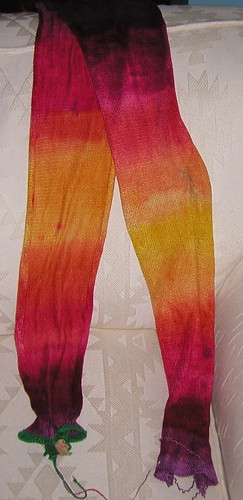
Purples to fuchsias to golds and back again. I knew I would have to wind the bobbins in order, and keep track of them. I imagined I would have to unwind the fabric onto a bobbin, then rewind each bobbin to get the colors to come out right: the beginning of each yarn on the bobbin needed to match up colorwise with the end of the previous bobbin (clear as mud? yeah, for me too). But my friend Lindsey knew, and could explain to me, that each bobbin could be wound off in order, then woven from the *opposite* end of the fabric and it would come out right.
I wound the bobbins and lined them up in weaving order.
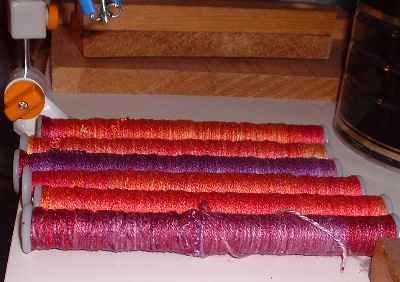
Not entirely trusting myself, I also numbered the bobbins (I know; anal):

Now, being the inveterate plain weaver, I also had to get input on just *which* twill would be effective in this fabric, and so I asked the general assembled at a gathering a few weeks ago. Dee simply said *two block turned twill*, which sounded good to me. But I've never woven it. So I had to look it up.
I turned to Handwoven's Index, and found an article by my friend Sharon Alderman on turned twill, entitled *Easy as Pi* (see Sept/Oct 2000 Handwoven, pp. 26-29). I liked the *easy* part of the title. Now, I have listened to Sharon's lectures, and know that she can make structure truly understandable to the neophyte (me), and she did. Using this draft, I guessed at the sett, and scrunched under the loom to tie up an 8 harness pattern weave (whew!).
Weaving progressed smoothly, as long as I remembered to treadle in block rotation. I set up my treadles to walk from right to left, and I am accustomed to walking them from the outside in. I had to remind myself to walk the outside treadles for the whole block, before moving into the center treadles. Here is the fabric on the loom:
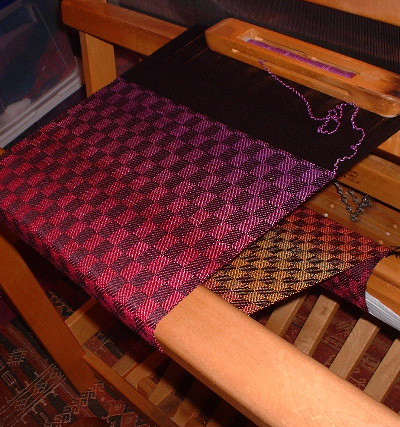
And just *off* the loom, before finishing:
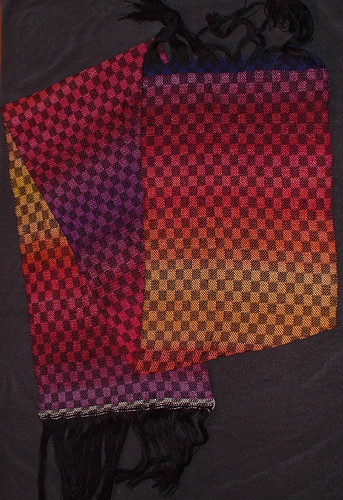
and on the *model* (Nancy, who came to town to be our guild speaker on this very subject, thus the pressure was on to finish this!):
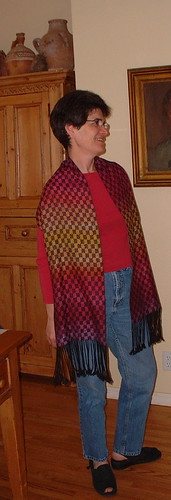
Well, since I was guessing all the parameters for this fabric, including the length this weft would weave, I ended up with extra warp. Quick as a flash I ran up to the house and retrieved my knit-hat-in-progress, the cashmere hat from this post. I've been knitting sporadically on this for months, but it's not very pleasing, or at least it was stalled. So here it is just before ripping it out:

And here is that fabric on the loom;
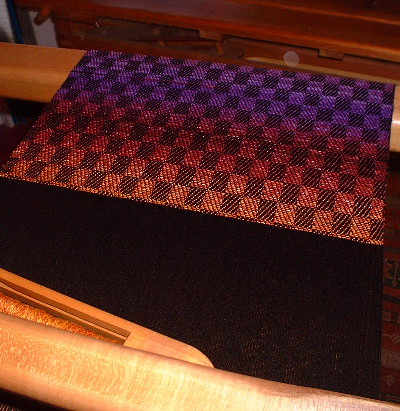
Handspun cashmere and silk, yay! Here's the fabric off the loom:
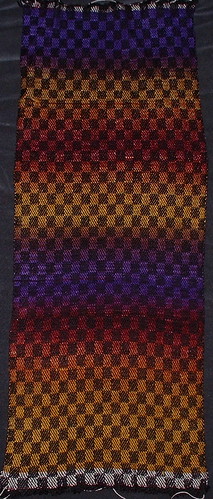
It is now washed, but I think I will full it more, and then cut out and *sew* a hat. Done. Done in an hour, vs. the many hours of knitting it would have required to finish. I'm so not a knitter! (I do have some several balls of this yarn left, I'm thinking another pair of fingerless gloves, can one have too many?).
This whole project gave Nancy and I several more ideas for fabric using knitted-dyed weft. More later! Her website should be up soon: www.machineknittingtodyefor.com
Many projects simply would not be, if it were not for help from my friends. This is one of them. Many months ago, I wrote about Nancy Roberts' dyeing knit fabric, and then re-knitting the yarn (see this post). Well, she also had an idea that dyed knit fabric could be used as weft, so I agreed to weave up a sample. The dyed silk fabric looked like this:

Purples to fuchsias to golds and back again. I knew I would have to wind the bobbins in order, and keep track of them. I imagined I would have to unwind the fabric onto a bobbin, then rewind each bobbin to get the colors to come out right: the beginning of each yarn on the bobbin needed to match up colorwise with the end of the previous bobbin (clear as mud? yeah, for me too). But my friend Lindsey knew, and could explain to me, that each bobbin could be wound off in order, then woven from the *opposite* end of the fabric and it would come out right.
I wound the bobbins and lined them up in weaving order.

Not entirely trusting myself, I also numbered the bobbins (I know; anal):

Now, being the inveterate plain weaver, I also had to get input on just *which* twill would be effective in this fabric, and so I asked the general assembled at a gathering a few weeks ago. Dee simply said *two block turned twill*, which sounded good to me. But I've never woven it. So I had to look it up.
I turned to Handwoven's Index, and found an article by my friend Sharon Alderman on turned twill, entitled *Easy as Pi* (see Sept/Oct 2000 Handwoven, pp. 26-29). I liked the *easy* part of the title. Now, I have listened to Sharon's lectures, and know that she can make structure truly understandable to the neophyte (me), and she did. Using this draft, I guessed at the sett, and scrunched under the loom to tie up an 8 harness pattern weave (whew!).
Weaving progressed smoothly, as long as I remembered to treadle in block rotation. I set up my treadles to walk from right to left, and I am accustomed to walking them from the outside in. I had to remind myself to walk the outside treadles for the whole block, before moving into the center treadles. Here is the fabric on the loom:

And just *off* the loom, before finishing:

and on the *model* (Nancy, who came to town to be our guild speaker on this very subject, thus the pressure was on to finish this!):

Well, since I was guessing all the parameters for this fabric, including the length this weft would weave, I ended up with extra warp. Quick as a flash I ran up to the house and retrieved my knit-hat-in-progress, the cashmere hat from this post. I've been knitting sporadically on this for months, but it's not very pleasing, or at least it was stalled. So here it is just before ripping it out:

And here is that fabric on the loom;

Handspun cashmere and silk, yay! Here's the fabric off the loom:

It is now washed, but I think I will full it more, and then cut out and *sew* a hat. Done. Done in an hour, vs. the many hours of knitting it would have required to finish. I'm so not a knitter! (I do have some several balls of this yarn left, I'm thinking another pair of fingerless gloves, can one have too many?).
This whole project gave Nancy and I several more ideas for fabric using knitted-dyed weft. More later! Her website should be up soon: www.machineknittingtodyefor.com

4 Comments:
That fabric is gorgeous! I love that idea for dyeing knit fabric and using the yarn for something else. Very clever!
That post was worth the wait.. holy smokes!! What a thought. How did I miss your first post on Nancy's technique. The fabric you came out with is stunning.
Very cool. Love the colors.
But this knitter says, better you than me.
;-)
The fabric is beautiful and the possibilities endless. I certainly don't think you're anal. I numbered the bobbins for my gamp. I was thinking the same thing you were about winding them. Is Lindsey available for consultations?
Post a Comment
<< Home